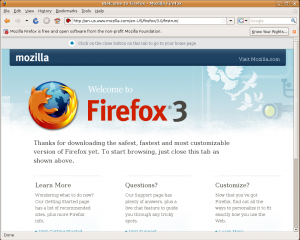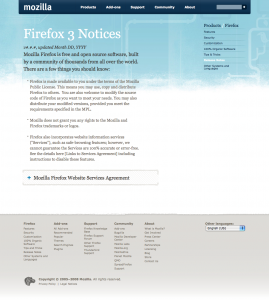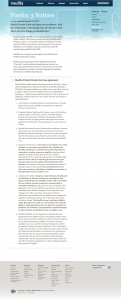Does UK Government Grok the GPL?
This is really quite interesting. It seems as though the UK government are starting, finally, to get the whole “Commons” thing.
There is this Government Department/Quango(?) called the Office of Public Sector Information (OSPI for short). Yep, I’ve never heard of them either. Not until I saw this tweet from Glyn Moody last night at any rate. The OSPI’s remit is (according to their website) as follows:
Operating from within the National Archives, the Office of Public Sector Information (OPSI) is at the heart of information policy, setting standards, delivering access and encouraging the re-use of public sector information. OPSI provides a wide range of services to the public, information industry, government and the wider public sector relating to finding, using, sharing and trading information.
The merger of OPSI with the National Archives in October 2006 enables the combined organisation to provide strong and coherent leadership for the development of information policy across government and the wider public sector.
OPSI has an important role as a regulator of public sector information holders for their information trading activities. The Information Fair Trader Scheme (IFTS) founded on the principles of openness, transparency, fairness, compliance and challenge helps re-users of public sector information to know that they will be treated reasonably and fairly. OPSI also investigates complaints against public sector information holders made under the Re-use of Public Sector Information Regulations.
OPSI provides the Click-Use system for obtaining a licence to re-use Crown copyright and public sector material through an online licensing process and is responsible for the Information Asset Register (IAR) that lists information assets held by the UK Government with a focus on unpublished material. OPSI also provides a secretariat to the Advisory Panel on Public Sector Information (APPSI), which advises Ministers on how best to encourage the re-use of public sector information.
Operating from within OPSI, Her Majesty’s Stationery Office (HMSO) continues to exist and fulfil its core activities including responsibility for the publication of legislation and the management of Crown copyright.
Got that? Good. Although I’m still not sure I know what they “do”. I can see they are “at the heart of information policy” but anyway, let’s assume they do something important and worthy within the huge bureaucracy that is UK Government. The big news is they now have a blog! Called perspectives. The most interesting article (from 3 so far) on their new blog is this one where they introduce a new “Licensing Model” and are, more importantly, soliciting feedback:
The Government’s response to the Power of Information Taskforce’s recommendation 8 stated that OPSI was developing a new licence model, building on the success of the Click-Use Licence. We thought it would be good to post our initial thoughts about what the new licence terms could look like here on our blog for your comments.
Here’s the bit that caught Glyn’s eye and makes all us Freedom lovers go weak at the knees…
• The new licence terms are compatible with other standard licences such a Creative Commons and GNU GPL;
How interesting. I am not sure that I understand the full implications of the new license and what content/information it really pertains to, but the description of their remit above would suggest that it could be far reaching. Anyway, here is the license they propose in full below, but please don’t make specific license comments here, comment about the license over there, where the OSPI will see them.
Terms and conditions
Purpose
This licence explains how you may re-use a wide range of public sector information and what conditions apply. Under this licence the term information means any content, including any part of such content, whether in writing or stored in electronic form or as a sound, visual or audio-visual recording, other than computer programs and software.
What you can do
1. You can copy, publish, translate into other languages, adapt, mash and convert to Braille and other formats for people who are visually impaired.
What information is covered
2. All Crown copyright information can be re-used under this licence apart from the specific exemptions listed below.
3. Information produced by other public sector organisations as listed at [link to be inserted].
What information is not covered
4. Crown copyright information produced by government departments and trading funds that are responsible for licensing the re-use of the information they commission or produce. Details of these organisations can be found at [link to be inserted]
5. Information where re-use is not permitted for policy reasons, for example the HSE Health and Safety Law poster.
6. Information that is exempt under Freedom of Information legislation and the Environmental Information Regulations.
7. Personal information about named individuals.
8. Official imprints, public sector organisation logos, badges, crests and insignia of the armed forces. This includes the Royal Arms unless they form an integral part of the information that you are re-using.
Your obligations
9. You must:
• Re-use the information accurately
• Acknowledge the copyright and the source of the information, for example the title of a report and the name of the department that issued it.
• Not re-use the information in a deliberately misleading way.
• Not re-use the information for promotional or advertising purposes; not to imply endorsement by a government department or other public sector organisation.
• Not mimic the style and appearance of the original information, for example by replicating the look and feel of a published document or a departmental website.Disclaimer
Your use of the information covered by this licence is entirely at your own risk. OPSI makes no warranty, representation or guarantee that the information is error free.
Governing law
This licence is made under the laws of England and Wales and comes under the exclusive jurisdiction of the courts of England and Wales.
There are a couple of comments already and they cover the obvious.
Not being a lawyer I am not sure if I quite “get” why they (we?) need a new license though? Why could they not simply use any of the CC licenses as appropriate?
Anyway, if you spot anything in the detail or wish to simply make your voice heard, you know where to go.
The Open Sourcerer Gets A New Theme
I’ve been meaning to do this for some time now. It is time for a small face-lift.
I spend quite a bit of my time doing work for clients on Joomla! including building clean templates from a graphic designer’s images. But I haven’t needed to build a template (theme) for WordPress before which felt like I’d been missing out on or something.
So, here is my first – from scratch – WordPress theme. I’ve called it “Open Sourcerer”. I hope you like it and it works in your browser; please do tell me if it doesn’t although any IE6 users will have to put up with a fixed width layout because I really can’t be arsed to hack around that oh-so-crappy browser when I’m not being paid. Another great “feature” of IE 6 & 7 from my tests is that apparently Microshit are unable to make the text cursor (I-beam) adapt to the environment it finds itself in, so consequently it is very hard to see it against this dark brown background colour. Honestly, is it really so bloody hard to get right? Firefox seems to manage it fine, as does Midori, a “lightweight” Webkit based browser. So if you are reading this with IE and wonder where your cursor has gone, go and get a proper browser for pete’s sake. Anyway, enough of trying to pander to bad commercial software.
This theme is a flexible-width layout from 800-1200px wide which should be fine for most users. The sidebar with the widgets is fixed at 215px currently. If there are any WordPress gurus out there I’d appreciate any feedback on what’s missing or important from this theme. Comparing “Open Sourcerer” to the Default theme there are quite a few other php files in there which I saw no need for. Perhaps overriding the defaults is only necessary if you have a specific kind of layout?
After reading a bit and getting nowhere regarding how to create a WordPress theme from scratch, I came across this gem of a how-to. It’s concise, clear, straightforward and simple. That suited me fine and got me started; thank you Sam Parkinson for sharing your knowledge with us.
 I really like dark backgrounds for blogs. The inspiration for this one started by stumbling across this Dark Smoke theme quite by accident and then thinking about the colours of the “New Wave” and “Dust” themes for Gnome that are supplied in Ubuntu 9.04 (Jaunty Jackalope). Here is my desktop using the Dust theme (yes I know I shouldn’t have all those files lying around!).
I really like dark backgrounds for blogs. The inspiration for this one started by stumbling across this Dark Smoke theme quite by accident and then thinking about the colours of the “New Wave” and “Dust” themes for Gnome that are supplied in Ubuntu 9.04 (Jaunty Jackalope). Here is my desktop using the Dust theme (yes I know I shouldn’t have all those files lying around!).
So, what you see here is a fairly simple 2 column theme, that is flexible in width between 800 and 1200px. The lovely dark brown [almost black] background colour is the same as used in the Dark Smoke theme mentioned above. The other browns are simply lighter shades of the same I achieved in Gcolor2 by just shifting the brightness value. The red is The Open Learning Centre‘s logo colour (#D40000) and the main text colour is taken straight from the Gnome windows and panels in a default Ubuntu desktop using the Dust theme. As for typefaces, if you have the free and open Liberation fonts installed, which I strongly recommend, that will be the font-type rendered. Alternatives are (in order) Arial, Helvetica, sans-serif;
The graphic at the top is a section cut from one of the fantastic Hubble telescope images that are freely available. This one in fact.
One aspect of template creation and maintenance I am very keen on is the separation of stylesheets by function. In the main style.css file in my theme, you won’t find much actual styling other than some global resets. What you will see however is this:
/* Make it easy to alter stuff... */
@import url("css/layout.css");
@import url("css/header.css");
@import url("css/menu.css");
@import url("css/content.css");
@import url("css/sidebar.css");
@import url("css/footer.css");
@import url("css/wordpress.css");
@import url("css/tweeks.css");
Hopefully the names of the stylesheets are enough to identify what styling they contain. To my mind this makes it so much easier to navigate when you want to make a change as opposed to trawling through one very long and usually randomly ordered stylesheet.
You can download the theme from here and can modify, hack and/or edit as you wish. It is released under the GPLv3 License.
Update: I made a few small changes to the theme in the vain hope that it may be acceptable for the WordPress.org Theme Directory. Thanks Kirrus for making the suggestion. It was a good idea and made me test my theme more thoroughly too!
Update 2: It worked. This theme has been accepted and is now being hosted on the Theme Directory. I wrote a short piece about that here.
Wolfie get’s his Glorious Day
Fantastic. Mozilla have clearly been listening…
These are just mock-ups but I doubt that they’d be showing something far from what will transpire. It looks nice, requires no consent, and certainly wouldn’t aggravate me.
Update, now you can also see some mock-ups of how the license gets shown too.
And here is the Website Services Agreement:
No SHOUTING, and they look to have removed most of the cruft which made it utterly pointless. I’m not convinced it is still necessary to actually do all this, and I would prefer if the “services” which cause all this grief (the anti-phishing and scam detection) were disabled by default.
But, this is definitely a massive improvement over where we were a couple of days ago…
Is Mozilla losing the plot? [Updated x2]
The creators and owners of the Open Source Firefox web browser seem to have ignited a bit of a war in the last few days.
In Ubuntu’s next development version (Intrepid Ibex) due for release next Month, Mozilla have demanded that for Ubuntu to continue to distribute Firefox, they must display an EULA.
This is the ONLY EULA I believe that is currently present in the “main” repository of Ubuntu and certainly the only one that a user would be required to accept in the default Ubuntu Desktop configuration as is currently supplied.
I like Firefox. It is a good browser. But I do not like having to accept an EULA that potentially restricts what I decide to do with this Free and Open Source software. And, if I am not mistaken, I think that this is actually a violation of the terms of the GPL under which most of the main Ubuntu distribution is supplied.
Ubuntu/Canonical does have a choice. It can compile it’s own version of Firefox and simply turn off the ac_add_options --enable-official-branding option. OK, it won’t be called Firefox any more but I suggest that users will either know and not care or not know and not care about the name change.
There is a rather long [and growing] set of comments associated to a BUG report on Launchpad. I’d recommend any and all Ubuntu Users to read and have their say – whatever that may be.
My personal opinion is that Ubuntu Ibex should ship with the Debian branded version of Firefox (called Iceweasel) for now and then take stock for future releases. They can always include true “Firefox” in their restricted repositories – but there is NO-WAY a peice of software requiring an EULA should be included in the default main repo.
Here is the EULA in all it’s gory detail [coloured emphasis mine]:
MOZILLA FIREFOX END-USER SOFTWARE LICENSE AGREEMENT
July 2008
A SOURCE CODE VERSION OF CERTAIN FIREFOX BROWSER FUNCTIONALITY THAT YOU MAY USE, MODIFY AND DISTRIBUTE IS AVAILABLE TO YOU FREE-OF-CHARGE FROM WWW.MOZILLA.ORG UNDER THE MOZILLA PUBLIC LICENSE and other open source software licenses.
The accompanying executable code version of Mozilla Firefox and related documentation (the “Productâ€) is made available to you under the terms of this MOZILLA FIREFOX END-USER SOFTWARE LICENSE AGREEMENT (THE “AGREEMENTâ€). BY USING THE MOZILLA FIREFOX BROWSER, YOU ARE CONSENTING TO BE BOUND BY THE AGREEMENT. IF YOU DO NOT AGREE TO THE TERMS AND CONDITIONS OF THIS AGREEMENT, DO NOT USE THE MOZILLA FIREFOX BROWSER.
DURING THE MOZILLA FIREFOX INSTALLATION PROCESS, AND AT LATER TIMES, YOU MAY BE GIVEN THE OPTION OF INSTALLING ADDITIONAL COMPONENTS FROM THIRD-PARTY SOFTWARE PROVIDERS. THE INSTALLATION AND USE OF THOSE THIRD-PARTY COMPONENTS MAY BE GOVERNED BY ADDITIONAL LICENSE AGREEMENTS.
1. LICENSE GRANT. The Mozilla Corporation grants you a non-exclusive license to use the executable code version of the Product. This Agreement will also govern any software upgrades provided by Mozilla that replace and/or supplement the original Product, unless such upgrades are accompanied by a separate license, in which case the terms of that license will govern.
2. TERMINATION. If you breach this Agreement your right to use the Product will terminate immediately and without notice, but all provisions of this Agreement except the License Grant (Paragraph 1) will survive termination and continue in effect.
3. PROPRIETARY RIGHTS. Portions of the Product are available in source code form under the terms of the Mozilla Public License and other open source licenses (collectively, “Open Source Licensesâ€) at http://www.mozilla.org/MPL. Nothing in this Agreement will be construed to limit any rights granted under the Open Source Licenses. Subject to the foregoing, Mozilla, for itself and on behalf of its licensors, hereby reserves all intellectual property rights in the Product, except for the rights expressly granted in this Agreement. You may not remove or alter any trademark, logo, copyright or other proprietary notice in or on the Product. This license does not grant you any right to use the trademarks, service marks or logos of Mozilla or its licensors.
4. PRIVACY POLICY. The Mozilla Firefox Privacy Policy is made available online at http://www.mozilla.com/legal/privacy/, as that policy may be changed from time to time. When Mozilla changes the policy in a material way a notice will be posted on the website at www.mozilla.com and the updated policy will be posted at the above link.
5. WEBSITE INFORMATION SERVICES. Mozilla and its contributors, licensors and partners work to provide the most accurate and up-to-date phishing and malware information. However, they cannot guarantee that this information is comprehensive and error-free: some risky sites may not be identified, and some safe sites may be identified in error.
6. DISCLAIMER OF WARRANTY. THE PRODUCT IS PROVIDED “AS IS†WITH ALL FAULTS. TO THE EXTENT PERMITTED BY LAW, MOZILLA AND MOZILLA’S DISTRIBUTORS, AND LICENSORS HEREBY DISCLAIM ALL WARRANTIES, WHETHER EXPRESS OR IMPLIED, INCLUDING WITHOUT LIMITATION WARRANTIES THAT THE PRODUCT IS FREE OF DEFECTS, MERCHANTABLE, FIT FOR A PARTICULAR PURPOSE AND NON-INFRINGING. YOU BEAR THE ENTIRE RISK AS TO SELECTING THE PRODUCT FOR YOUR PURPOSES AND AS TO THE QUALITY AND PERFORMANCE OF THE PRODUCT. THIS LIMITATION WILL APPLY NOTWITHSTANDING THE FAILURE OF ESSENTIAL PURPOSE OF ANY REMEDY. SOME JURISDICTIONS DO NOT ALLOW THE EXCLUSION OR LIMITATION OF IMPLIED WARRANTIES, SO THIS DISCLAIMER MAY NOT APPLY TO YOU.
7. LIMITATION OF LIABILITY. EXCEPT AS REQUIRED BY LAW, MOZILLA AND ITS DISTRIBUTORS, DIRECTORS, LICENSORS, CONTRIBUTORS AND AGENTS (COLLECTIVELY, THE “MOZILLA GROUPâ€) WILL NOT BE LIABLE FOR ANY INDIRECT, SPECIAL, INCIDENTAL, CONSEQUENTIAL OR EXEMPLARY DAMAGES ARISING OUT OF OR IN ANY WAY RELATING TO THIS AGREEMENT OR THE USE OF OR INABILITY TO USE THE PRODUCT, INCLUDING WITHOUT LIMITATION DAMAGES FOR LOSS OF GOODWILL, WORK STOPPAGE, LOST PROFITS, LOSS OF DATA, AND COMPUTER FAILURE OR MALFUNCTION, EVEN IF ADVISED OF THE POSSIBILITY OF SUCH DAMAGES AND REGARDLESS OF THE THEORY (CONTRACT, TORT OR OTHERWISE) UPON WHICH SUCH CLAIM IS BASED. THE MOZILLA GROUP’S COLLECTIVE LIABILITY UNDER THIS AGREEMENT WILL NOT EXCEED THE GREATER OF $500 (FIVE HUNDRED DOLLARS) AND THE FEES PAID BY YOU UNDER THE LICENSE (IF ANY). SOME JURISDICTIONS DO NOT ALLOW THE EXCLUSION OR LIMITATION OF INCIDENTAL, CONSEQUENTIAL OR SPECIAL DAMAGES, SO THIS EXCLUSION AND LIMITATION MAY NOT APPLY TO YOU.
8. EXPORT CONTROLS. This license is subject to all applicable export restrictions. You must comply with all export and import laws and restrictions and regulations of any United States or foreign agency or authority relating to the Product and its use.
9. U.S. GOVERNMENT END-USERS. This Product is a “commercial item,†as that term is defined in 48 C.F.R. 2.101, consisting of “commercial computer software†and “commercial computer software documentation,†as such terms are used in 48 C.F.R. 12.212 (Sept. 1995) and 48 C.F.R. 227.7202 (June 1995). Consistent with 48 C.F.R. 12.212, 48 C.F.R. 27.405(b)(2) (June 1998) and 48 C.F.R. 227.7202, all U.S. Government End Users acquire the Product with only those rights as set forth therein.
10. MISCELLANEOUS. (a)This Agreement constitutes the entire agreement between Mozilla and you concerning the subject matter hereof, and it may only be modified by a written amendment signed by an authorized executive of Mozilla. (b) Except to the extent applicable law, if any, provides otherwise, this Agreement will be governed by the laws of the state of California, U.S.A., excluding its conflict of law provisions. (c) This Agreement will not be governed by the United Nations Convention on Contracts for the International Sale of Goods. (d) If any part of this Agreement is held invalid or unenforceable, that part will be construed to reflect the parties’ original intent, and the remaining portions will remain in full force and effect. (e) A waiver by either party of any term or condition of this Agreement or any breach thereof, in any one instance, will not waive such term or condition or any subsequent breach thereof. (f) Except as required by law, the controlling language of this Agreement is English. (g) You may assign your rights under this Agreement to any party that consents to, and agrees to be bound by, its terms; the Mozilla Corporation may assign its rights under this Agreement without condition. (h) This Agreement will be binding upon and inure to the benefit of the parties, their successors and permitted assigns.
What a mouthful. I’m sure that even the legal team at Microshaft would be proud of it!
I highlighted a couple of areas that I think I understand…
BY USING THE MOZILLA FIREFOX BROWSER, YOU ARE CONSENTING TO BE BOUND BY THE AGREEMENT.
When I read this EULA after a routine update to Ibex on Saturday, it just appeared to me in a tab of Firefox next time I restarted. If you are using Ibex and you missed it last time round, just start Firefox from a terminal thus: firefox -ProfileManager, create a new profile, and you should get it again. My understanding of the quote above is that as I am now reading the contents of the EULA in Firefox I have, without my express consent, actually agreed to this garbage.
You must comply with all export and import laws and restrictions and regulations of any United States or foreign agency or authority relating to the Product and its use.
Hang on. I’m an end user. WTF have export and import laws got to do with me? And how on earth am I supposed to be aware of and understand “all export and import laws and restrictions and regulations of any United States or foreign agency or authority“. That’s a pretty bloody tall order by my understanding.
I’m sorry Mozilla, but this just stinks!
And OH YES. WHY DO YOU HAVE TO SHOUT IT ALL TOO?
Update 2: Mitch Baker has just posted a blog entry. Basically it sounds like they fscked up but haven’t worked out a fix – yet.
More on Number 10’s website fiasco
Being “that-kind-of-a-bloke”, I thought I’d dig a bit further into the Number 10 Steals Free WordPress Theme story 😉
Here’s the background:
- No. 10 Are running WordPress1
- The theme (or template) is based on one called NetWorker2
- The attribution and copyright notice that is in the original footer has been removed
- The site claims to be Crown Copyright and makes no reference to the CC-by-sa license used in the original template
I am a bit confused here. Why would a web design shop (or “Full Service New Media Agency” as they call themselves), who were apparently paid the best part of £100k for this job3, use somebody else’s template as the basis for their design?
- You might think it would be because using a pre-made template would save you loads of tricky coding and playing around with CSS trying to get your site to look the same in IE6, IE7, Firefox, Safari and Opera [A task I am quite familiar with myself].
- You might also think that using a pre-made template would allow you to make minor modifications, add some different images and give you something that looks really different.
- Of course it might be simply that you don’t have time to create a new theme from scratch and using an “off-the-shelf” template will mean you can get the site up and running much faster.
- Or another possibility could be that you like ripping off your customers for as much as possible and using a free (or even a bought) template will mean your costs are minimal.
All, some, or none of the above could be reasons to use an existing template as a basis for your new design.
So how much new coding would be needed making the changes to an existing template to suit your new design? 10%, 20%, maybe even 50% and it would still be worth while…
Get this: the revised stylesheet from Anthony Baggett’s template is more than 6 times the original’s length and size! And that isn’t all made up of whitespace either…
The original stylesheet4 is 612 lines in length and is 9234 bytes in size (9KB).
The modified stylesheet5 is 3826 lines long and weighs in at a frankly astonishing 63724 bytes (63KB)!
You can obviously download the two stylesheets from their websites directly (I recommend using a plugin for Firefox called Web Developer) or to make things easier, I have made them available at the bottom of this page.
Looking through the new file, the amount of duplication and repetition of styling of the same, or very similar elements, is quite odd. It certainly isn’t the way I would construct a theme. Why duplicate the same styling over, and over, and over again when you could craft the logic so that each of these elements have a commonality that could then be controlled with a much smaller stylesheet?
Here are a few screenshots showing some of the differences between the two files. In the brilliant Open Source comparison application Meld I’m using here, the original stylesheet is shown in the left pane and the modified one is on the right. The first image shows the very top of both files with Anthony’s header still in tact. The second and third are just a couple of fairly random points where the new file contains a great deal of repetition as I am walking down through the files. The final image shows the bottom of both files (note the line numbers!).
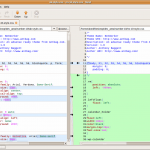
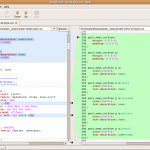
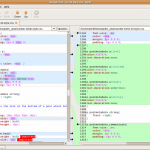

One thing that is clear from using a tool like Meld is that these two files are definitely related. The way the application displays the differences, it is clear where the files are the same and where they differ. The larger file is certainly a derivative work of Anthony’s original.
Another aspect I found rather funny in this investigation was the method of version control for this huge stylesheet. Both stylesheets have the same version number and there doesn’t appear to have been any tool used to update the header as would be usual. How on earth does a business that develops a ~4000 line stylesheet manage to do that without using some sort of versioning system?
I have helped businesses use and modify pre-made templates for Joomla!, and to be honest if you are making changes of any significance to these templates, it is almost always easier and quicker and cheaper to start from scratch. For small mods and changes pre-bought templates can be really good value (I mean $50 is fairly average), but getting your head around someone else’s code is never easy and takes considerable time. For major alterations it just doesn’t make financial sense.
Now, making additions and changes just to the stylesheet of more than 6 times the original is not good business sense in my opinion. How much more work have they done to the PHP code that we can’t see? We know they have modified at least index.php (by removing the WordPress statistic generator meta tag) and footer.php (by removing Anthony’s copyright notice). But if they have made SO MANY changes and additions to the stylesheet, there surely must be a good deal of altered php code, or additions, in the core php files too? Surely, it would have been easier to make a new template from scratch in this instance?
This leads on to the other question that might be worth digging into a bit more; GPL violations:
“If” the developers have modified the WordPress engine, as is being suggested as a possibility here, and then sold it to the Government, in my humble understanding that means they have distributed their modifications. That means those modifications must also be licensed under the GPL. I had a quick look on New Media Maze’s web site and couldn’t find an area for software downloads or mention of the GPL. That doesn’t say anything to be honest and there might be nothing to this, but it would be interesting to find out a bit more… Is there a real WordPress guru who can look at the “footprint” of the XHTML the site generates and tell if it is different? Or are there any other ways to tell if it has been modified?
Anyway, what a wheez this all is for us bloggers: It just isn’t Gordon’s year is it…
1. www.number10.gov.uk/
2. NetWorker Theme
3. £100k for WordPress site
4. Anthony’s original stylesheet
5. No. 10’s heavily modified stylesheet
Our new website
I switched on our new website this morning. It has taken far longer than I anticipated, but these things always do don’t they?
The layout and general idea is my own design, although the colour palette itself came from here which I thought was a brilliant resource. Using the search tool, I had the main colour for our Logo (#D40000) and this site threw up several ideas which were very nice indeed. I liked Rich Choice Lighten the most.
The initial idea for the menu came from Stu Nicholls’ excellent site CSS Play. I tried to use this menu in my original design but it didn’t play well with Joomla! and the accursed IE6 browser – man that is one bad web browser. So I opted for the really great swMenuFree native Joomla! module instead.
The site is running on Joomla! 1.5 and is still a WIP (Work In Progress) but then it probably always will be to be honest. There’s quite a bit of content still to do – mainly around the technology section – adding and describing applications that we feel are important and deserve covering. But now the framework is in place we can add to it fairly easily.
I will be packaging the template up shortly. It’s GPL and will be available for download from the site, probably under the resources section somewhere.
Any comments about it are very welcome. Our old site badly needed a refresh and this is quite a big change, although I definitely think it is more professional looking.

